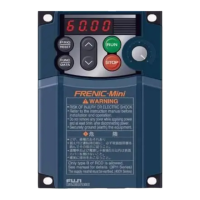7.1 Selecting Motors and Inverters
7-3
Chap. 7 SELECTING OPTIMAL MOTOR AND INVERTER CAPACITIES
(4) Braking torque (Curves (d), (e), and (f) in Figures 7.1 and 7.2)
In braking the motor, kinetic energy is converted to electrical energy and regenerated to the DC link bus
capacitor (reservoir capacitor) of the inverter. Discharging this electrical energy to the braking resistor
produces a large braking torque as shown in curve (e). If no braking resistor is provided, however, only the
motor and inverter losses consume the regenerated braking energy so that the torque becomes smaller as
shown in curve (d).
Models of 2 HP to 5 HP, 3-phase 230/460 V are each available in a braking resistor built-in type in which
the braking torque equivalent to that of the optional braking resistor can be obtained without an optional
resistor.
For more information, refer to Chapter 8, Section 8.2.2 "Braking resistor built-in type."
When an optional braking resistor is used, the braking torque is allowable only for a short time. Its time
ratings are mainly determined by the braking resistor ratings. This manual and associated catalogs list the
allowable values (HP) obtained from the average discharging loss and allowable values (kWs) obtained
from the discharging capability that can be discharged at one time.
Note that the torque % value varies according to the inverter capacity.
Selecting an optimal braking unit enables a braking torque value to be selected comparatively freely in the
range below the short-time maximum torque in the driving mode, as shown in curve (f).
For braking-related values when the inverter and braking resistor are normally combined, refer to
Chapter 6, Section 6.4.1 [1] "Braking resistors."

